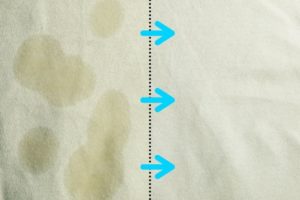Picture this: you’re enjoying a peaceful Sunday brunch, surrounded by family and friends. Laughter fills the air, and the aroma of freshly cooked food wafts through the house. You’re pouring a bottle of olive oil for the salad, and suddenly – *splat!* You miss the bowl and a generous amount of olive oil lands directly on your beautiful hardwood floor. Panic sets in – how are you going to get that greasy stain out?!

Image: inthewash.co.uk
Don’t worry, it happens to the best of us. Olive oil stains can feel daunting, but with the right approach and a few helpful tips, you can successfully remove the stain and restore your floor to its former glory. Let’s dive into the world of wood floor stain removal, and equip ourselves with the knowledge to tackle this common household dilemma.
Understanding the Nature of Olive Oil Stains
Olive oil, a culinary staple, is a natural oil extracted from olives. Its rich, fatty composition makes it a delicious addition to cooking and salad dressings, but it also means it can cling to wood surfaces, creating stubborn stains. The stain originates from the oil molecules penetrating the wood’s pores and leaving a greasy residue.
The trick to removing olive oil stains lies in breaking down this greasy residue and preventing it from settling deeply into the wood. We’ll explore several methods that target the oil and restore the wood’s natural beauty.
How to Remove Olive Oil Stains From Your Wood Floor
Step 1: Immediate Action
Time is of the essence! The sooner you address the spill, the easier it will be to remove. Start by blotting up as much excess oil as possible using a clean, absorbent cloth or paper towels. Avoid rubbing, as this will spread the oil and make the stain worse.

Image: shop.truckmountforums.com
Step 2: Choose Your Cleaning Solution
There are several effective solutions for removing olive oil stains from wood floors, ranging from everyday household items to specialized cleaning products. Here’s a breakdown of commonly used methods:
- Baking Soda and Dish Soap: Make a paste by combining baking soda and a few drops of dish soap. Apply the paste to the stain and let it sit for about 15 minutes. Then, scrub gently with a soft-bristled brush, and rinse with warm water. The baking soda acts as an absorbent, while the dish soap cuts through grease.
- Cornstarch: Sprinkle cornstarch directly onto the stain, covering it completely. Allow it to sit for a few hours to absorb the excess oil. Afterward, vacuum up the cornstarch. If the stain persists, repeat the process.
- White Vinegar: Dilute white vinegar with water in a 1:1 ratio. Apply the mixture to the stain using a clean cloth. Let it sit for a few minutes and then blot with a dry cloth. The vinegar’s acidity helps break down the oil.
- Commercial Wood Floor Cleaners: Look for cleaners specifically designed for wood floors that are safe for use in your home. Follow the product’s instructions carefully. These cleaners often contain ingredients that effectively remove grease and grime.
Tips and Expert Advice for Stain Removal
Here are some additional tips to ensure successful olive oil stain removal:
- Test in an Inconspicuous Area: Before applying any cleaning solution to the entire stain, test it on a small, hidden area of the floor. This ensures the cleaning agent doesn’t damage the wood finish.
- Work in a Well-Ventilated Area: When using cleaning solutions like vinegar, ensure proper ventilation to avoid inhaling the fumes.
- Be Patient: Removing olive oil stains may require several attempts. Be patient and persist, applying a light touch to prevent damaging the floor.
- Protect Your Floor: Once the stain is removed, consider applying a protective sealant or wax to your floor to prevent future oil spills from penetrating the wood.
- Seek Professional Help: For stubborn or deep stains, consider contacting a professional wood floor cleaning service. They have specialized equipment and techniques that can effectively remove even the most challenging stains.
Frequently Asked Questions
Q: Can I use a hairdryer to help remove the olive oil stain?
A: While a hairdryer can help dry a wet surface, it should not be used directly on an olive oil stain. Heat can actually set the stain deeper into the wood, making it even harder to remove.
Q: I’ve tried all the methods, but the stain is still there. What can I do?
A: If you’ve exhausted all other options, a professional wood floor cleaning service may be your best bet. They have specialized cleaning solutions and equipment to tackle even the most stubborn stains.
Q: How do I prevent future olive oil spills on my wood floor?
A: Take precautions by using a non-slip mat or a protective layer over your floor when working in areas where olive oil might spill. Also, store your olive oil in a secure location that’s easily accessible but away from high-traffic areas.
How To Get Olive Oil Out Of Wood Floor
Conclusion
Olive oil stains on your wood floor can be a frustrating experience, but with the right approach, you can effectively remove them. Remember to act quickly, choose the appropriate cleaning solution, and be patient throughout the process. Whether you opt for household remedies like baking soda and vinegar or invest in a professional service, you can restore your wood floor to its original beauty.
Are you ready to tackle those olive oil stains on your wood floor? Share your experiences and tips in the comments below! Let’s help each other keep our homes looking spotless and well-maintained.





